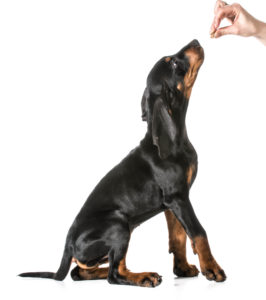
I love using food in training.
Close up or at a distance, it’s dead easy to deliver as a reward and dogs generally love it and want to work for it.
Some dogs will do cartwheels for cheerios (can anyone say “Labrador Retriever”)?
Food can be used not only as the perfect reinforcement for good behaviour, but it can also be used as a lure. Luring with food, i.e. getting a dog to target a food treat with his nose, can be used to elicit an amazing array of behaviours.
Fifteen years ago I had to spend a lot of time defending the use of food in training: about half of my clients needed some convincing. Now, most people are on board with it – and the dogs are thankful!
So what’s the problem?
Luring can go very wrong. When the technique is flawed it leads to doubts about its efficacy: “I tried using food in training, but it didn’t work” Sound familiar?
Here are 3 ways food lures can go wrong, and some very simple fixes:
What’s wrong? #1 – You’re using a lure for too long
When I first see clients with their dogs, I’ll ask them, “what have you trained him to do?” “Oh, he can sit!” they say proudly, and then they whip out a treat and ask for the sit. The dog is 5 years old, and still needs a cookie to do a sit? I guess it’s better than no sit at all, but honestly….dogs can do better.
The simple fix?
A general rule for luring is to use it the absolute fewest number of times you can to get the behaviour you want – otherwise the dog becomes dependent on the picture of lure-in-hand that you are presenting. Proper training includes fading the lure – getting it out of your hand and no longer relying on it to get your dog to do something, but instead, using it to reinforce something after the fact. Using a lure for too long really turns training into something more like bribery. Luring only a couple of times to get a behaviour, then fading the lure out of the picture, is the ideal training scenario. The dog may still need a hand signal for a bit, and the dog most certainly will still need reinforcement in the learning phase…but for the best training technique? Get the food out of the picture early!
What’s wrong? #2 – You’re fading the reward along with the lure
You have finally faded the lure, but along with fading the lure you’ve stopped giving your dog a food reward – and consequently your dog has stopped sitting, coming, staying….need I go on? Here’s what your dog learned when you stopped the food reward at the same time as the lure: “when my owner has food in her hand, I get a food reward. When my owner has no food in her hand and she asks me to do something I probably won’t get a food reward.” The dog is thinking: “What’s in it for me?” and the result is….ta da… a ‘stubborn’ dog – he only does it when you have food in your hand.
The simple fix?
Make sure that when you lose the lure, you up the chances that your dog will get a food reward. Do this: ask your dog for a sit, with no food present in your hand. When your dog sits make the food reward magically appear! It can come out of your pocket, or off a shelf, or out of your bait bag….I don’t care if it comes out of your ear as long as your dog thinks that you are a food magician. And to really turn the tables? Put food in your hand, ask for a sit and when your dog complies…just praise enthusiastically – no food reward! Follow up that trick with again, asking for a sit with no food in your hand and having the reward magically appear when butt hits the ground. See how that blows your dog’s mind!
What’s wrong? #3 – You’re luring and talking (and maybe even doing the hokey-pokey) all at the same time
Most people come into my Adolescent Fundamentals classes having taught their dogs some kind of sit. But when I ask students to stand tall and straight and still as a fence post, and ask their dogs for a sit, many of the dogs look at them like they’re speaking Chinese…What gives? The dogs haven’t learned English as a second language! It’s a basic mechanical error in dog training.
Dogs pay a lot of attention to physical prompts – this makes total sense for beings that rely so heavily on body language to communicate. If you mix up luring with your body language and your voice, your dog has to make a choice about what the most relevant bit is – most dogs are going to choose the moving parts over your “blah-de-blah”.
The simple fix?
Ideally, you’ve faded the lure and you’re working with a hand signal. Say your verbal cue first – with no hand movements, no head bobbing, no knee bending, no food waggling….nada. Now, about one second later, signal your dog to do the behaviour and when he does, whip out the food reward and make a big fuss. With repetition your dog will learn to jump the gun and respond to your words without all the gestures.
Now it’s your turn.
Have you made any of these food lure mistakes when training your dog? Where’d you go wrong and how did you fix it? I’d love to hear from you – leave a comment on the blog.

0 Comments